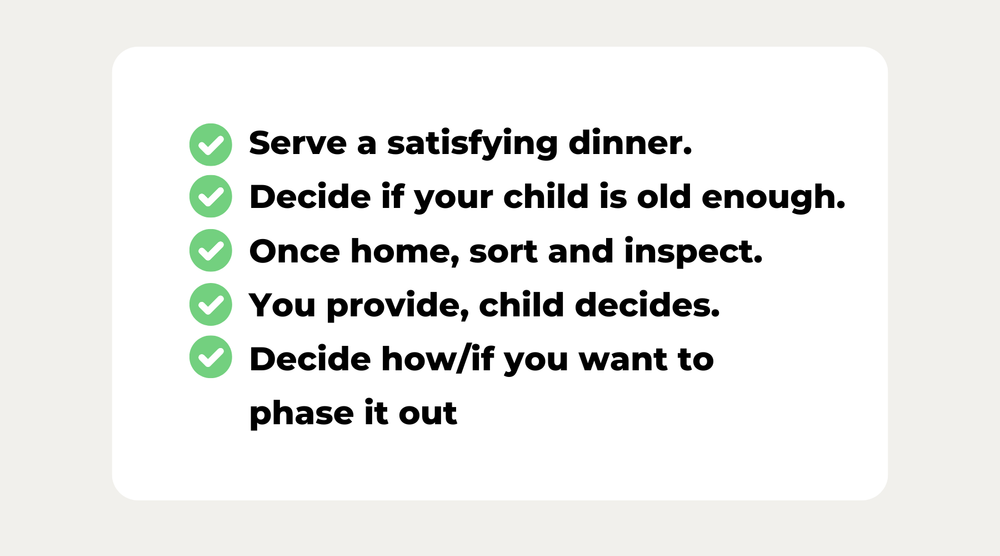
If you have signed up for our online Toddler & Kid Course (specifically the step on Desserts and Sugar), you know that our approach to Halloween candy may be a bit different than you would expect for people who talk about nutrition for a living. Sure, candy is not a “health food”…but we eat for many reasons. Health isn’t always one of them. And collecting, sorting and enjoying Halloween candy is one of the joys of childhood for many kids.

As with most things parenting-related, it’s all about balance and seeing the big picture. Candy will likely be part of your child’s normal food landscape. We can help them learn to manage it and get their fill so they don’t feel compelled to sneak or binge on it. Furthermore, we won’t always have control of how or what our kids eat – it’s important for us to continue to let them trust their bodies and hunger/fullness cues so they can rely on them as they gain more independence.
Oftentimes parents assume that when they completely restrict sugar or candy, their kids simply won’t want it or won’t gravitate toward it. Research suggests otherwise. More restrictive habits around food actually lead to children eating beyond their hunger cues. This makes sense – we tend to want what we perceive we cannot have. Read more about this in our blog post all about sugar.
Also remember, it’s OK to eat something simply because you love it. Not everything has to be eaten for our physical health. When we are satisfied by the foods we eat, we are more likely to eat an amount that’s appropriate for our body and move along with our day. Food has less emotional power over us when it’s neutral, not “good” vs. “bad.”
So, how do we handle this with Halloween or other holiday candy? The main premise is to let them have their fill when you decide to serve the candy and to not make a big deal out of it. Don’t use it as a bribery tool or as a reward – you’ll automatically elevate the candy and make it seem “special.” Remember, we want what we perceive is “off-limits.”
Here’s how we recommend handling it:
1. Offer a filling dinner and plenty of water before trick-or-treating. If your kid is hangry during trick-or-treating they may want to eat on the run, which can be a safety hazard. They also might want to fill up on candy because they’re so hungry. Before you head out, offer a protein-packed meal like spaghetti and meatballs, chili, turkey burgers or pizza.
2. Decide if your kiddo is old enough for candy. Most babies aren’t ready for many types of candy because it’s difficult to chew, plus babies don’t quite understand what they’re missing. One- and two-year-olds may be very aware that they’re receiving candy and may want to try it, especially if they have older siblings or friends. As the parent, it’s your choice whether or not to start exploring candy with your young toddler. (In our home we allow our kids to try Halloween candy once they’re one year of age, but this is a decision you’ll have to make.) If your child is going Trick-or-Treating, it may be difficult for them to understand why they can’t eat the candy.
3. Once you get back home, sort it! Remove any choking hazards or candies that may be difficult to chew like taffy, gum, or hard candy for kids under 4. (Use this opportunity to put together a Parent Stash of your favorites! You know, for safety and all…)
4. Allow your child to sort, explore and eat as much candy as they want when you get home. Try not to comment on how much they are eating or pressure them to stop. Also, avoid overexcitement about candy – remember, we want our kids to see all food as food, not “something special.” Let them feel their own fullness and decide when to stop. If you haven’t been doing this with your kiddos, they may test you and overeat – which may lead to a stomachache. Try not to take the “see, I told you so” route with them; rather, gently discuss what happened and explain that sometimes if we eat more than our belly is hungry for, it hurts. If you start this approach young, you will likely be very surprised by how little your little actually eats! You might also notice that they’re more interested in collecting and sorting the candy than actually eating it.
5. You provide, child decides. Decide how often you want to serve Halloween candy again for the next few weeks. Maybe you have some with each dinner or put some in their school or daycare lunch for a few days.
When you do serve it, let your child decide how much to eat and avoid tying it to behaviors (“You must finish your vegetables to get candy” or “No candy if you don’t clean up your toys”). Rather, serve it with or after meals without making a fuss about it. You can do it once, five times, with every meal, or never again – this is up to you. If you remain neutral about it, oftentimes children lose interest.
Important caveat: we still recommend that you as the parent decide when it’s served. If your child has constant access to candy, they might not have an appetite for other foods. Remember, you provide food of your choice at regular meals – they decide how much to eat.
6. Decide if you want to phase it out. In our family, after a few weeks my kids forget about the candy altogether and I donate it to our school or dentist (they usually have candy drives). Interestingly, they don’t notice it and don’t discuss it. Some families keep it longer or put it in the freezer. We don’t recommend having kids use it as payment (like the “switch witch”) because that makes the candy seem extra special. Rather, phase it out how it seems appropriate for your family or continue to enjoy it until it’s gone. (Note: the “switch witch” might be a good idea for kids with allergies or medical issues who cannot safely eat candy they received on Halloween.)
What about candy bowls? Some families keep candy out all the time, especially after Halloween. As my kids have gotten older, this is something I've done too, and it has helped to normalize candy for my kids. As expected, with more exposure, they're less excited about the candy. However, you'll have to decide if you want to try this in your family.
Need more help with mealtime? Check out our video-based online courses, which have helped thousands of parents raise happy, confident eaters!
